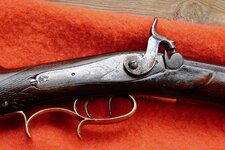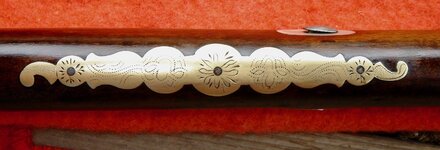Staff Member
Gold Supporter
Bronze Lifetime
- Messages
- 23,423
- Reactions
- 112,174
Here I am referring to original plains rifles...not the currently made Lyman Plains Rifle.
Which is a fine rifle...just not the one I am taking about in this post.
A plains rifle is a modern generic term for a rifle that was made to used on the America Great Plains for big game.
The period correct terms are Trade Rifle or Sporting Rifle.
Calibers generally range from .45 - .60 . ( Two of the more common calibers are .47 and .52 )
Do not use the caliber alone as guide to how old the rifle is....as these calibers are seen through out this type of rifle's time periods of use.
Caliber by the way...is a more modern term...the 18th and 19th century term was balls to the pound or gauge....
Stocks are usually either maple or walnut , full or half-stocked...the maple is usually plain..but not always....
Many Leman Plains rifles with maple stocks have been artificially striped...So much like today , a rifle with a pretty wood stock may have been a selling point.
Ignition may be flint or percussion.
Patch boxes and or cap boxes are seen from time to time...if engraved , the engraving is sparse ( usually ) .
Furniture will be brass or iron..at times it can be mixed...
But if this was done on purpose or if it was a period repair , may be tough to tell.
Many rifles of this type were used in the Fur Trade and are called "Trade Rifles"...as in rifles for use in the fur trade or gun trade.
These rifles were meant to be used both by trappers and for trading to the tribes for pelts , hides , horses , etc...
Trade rifles were "mass produced" on a basic pattern , many folks working together to make one rifle...on a assembly line in a factory.
Rifles of this type are fine , sturdy rifles , made to work ...but as a rule not as finely finished as a "sporting rifle" of the time period.
An exception to this , is the trade rifle , known as Chief's grade guns / Rifles...these are more finely finished and often have silver inlays , carving and engraving.
Some rifles of this type , are US marked...and were used as gifts for various tribes....these rifles so marked are referred to as Treaty Rifles
Treaty rifles at times came in smaller caliber such as .38 and .44 caliber.
A popular theory for this is that these calibers are better suited for hunting smaller game , like deer and such and not as good for warfare.
I have not seen a 19th century period reason for the rifles with the smaller calibers ...so take the above popular theory with a grain of salt.
Sporting Rifles...
Sporting Rifles are much like Trade Rifles but , more finely finished and not as uniform in regards to a pattern.
Calibers range from .31 - .60
Favorites being .31 , .38 , .47 and .53
Ignition may be either flint or percussion...and the stocks are again seen in maple or walnut , full or half stock.

J. Henry Trade Rifle...Maple Stock , flintlock , smoothbore .58 caliber circa 1800-1820

Leman Trade Rifle...Maple stock , artificially striped , percussion lock .50 caliber rifled...circa late 1830's - 1840's

Sporting Rifle made by F.E. Seiferth in St. Louis...Walnut stock , percussion lock .50 caliber rifled...circa 1840's -1850's
All three of the above rifles are still in use...both as shooting / hunting rifles or in my displays.
Andy
Which is a fine rifle...just not the one I am taking about in this post.
A plains rifle is a modern generic term for a rifle that was made to used on the America Great Plains for big game.
The period correct terms are Trade Rifle or Sporting Rifle.
Calibers generally range from .45 - .60 . ( Two of the more common calibers are .47 and .52 )
Do not use the caliber alone as guide to how old the rifle is....as these calibers are seen through out this type of rifle's time periods of use.
Caliber by the way...is a more modern term...the 18th and 19th century term was balls to the pound or gauge....
Stocks are usually either maple or walnut , full or half-stocked...the maple is usually plain..but not always....
Many Leman Plains rifles with maple stocks have been artificially striped...So much like today , a rifle with a pretty wood stock may have been a selling point.
Ignition may be flint or percussion.
Patch boxes and or cap boxes are seen from time to time...if engraved , the engraving is sparse ( usually ) .
Furniture will be brass or iron..at times it can be mixed...
But if this was done on purpose or if it was a period repair , may be tough to tell.
Many rifles of this type were used in the Fur Trade and are called "Trade Rifles"...as in rifles for use in the fur trade or gun trade.
These rifles were meant to be used both by trappers and for trading to the tribes for pelts , hides , horses , etc...
Trade rifles were "mass produced" on a basic pattern , many folks working together to make one rifle...on a assembly line in a factory.
Rifles of this type are fine , sturdy rifles , made to work ...but as a rule not as finely finished as a "sporting rifle" of the time period.
An exception to this , is the trade rifle , known as Chief's grade guns / Rifles...these are more finely finished and often have silver inlays , carving and engraving.
Some rifles of this type , are US marked...and were used as gifts for various tribes....these rifles so marked are referred to as Treaty Rifles
Treaty rifles at times came in smaller caliber such as .38 and .44 caliber.
A popular theory for this is that these calibers are better suited for hunting smaller game , like deer and such and not as good for warfare.
I have not seen a 19th century period reason for the rifles with the smaller calibers ...so take the above popular theory with a grain of salt.
Sporting Rifles...
Sporting Rifles are much like Trade Rifles but , more finely finished and not as uniform in regards to a pattern.
Calibers range from .31 - .60
Favorites being .31 , .38 , .47 and .53
Ignition may be either flint or percussion...and the stocks are again seen in maple or walnut , full or half stock.

J. Henry Trade Rifle...Maple Stock , flintlock , smoothbore .58 caliber circa 1800-1820

Leman Trade Rifle...Maple stock , artificially striped , percussion lock .50 caliber rifled...circa late 1830's - 1840's

Sporting Rifle made by F.E. Seiferth in St. Louis...Walnut stock , percussion lock .50 caliber rifled...circa 1840's -1850's
All three of the above rifles are still in use...both as shooting / hunting rifles or in my displays.
Andy

















